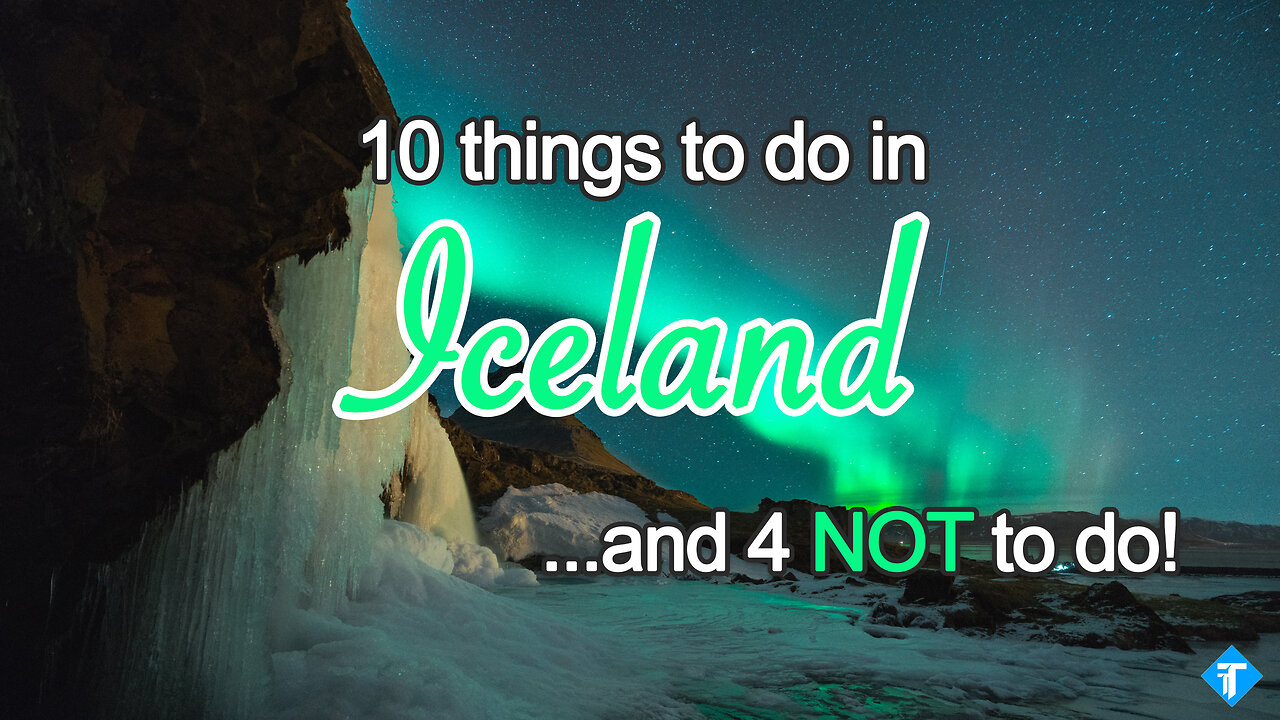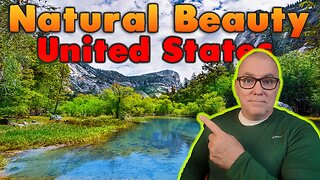Premium Only Content

10 Things To Do (and 3 NOT TO DO) in Iceland - Travel Guide
Reykjavík
Modern, dynamic, young, and constantly expanding, Reykjavik is often the first stop on a trip to Iceland. The contemporary presence of an airport and a port has greatly contributed to the prestige of the city, where over a third of the entire nation's population lives (approximately 122,000 inhabitants). The contribution of the English and Americans is also noteworthy. During World War II, the island became a crucial hub for Allied forces engaged in countering the Nazi advance. In exchange for military occupation, the small island of Iceland obtained a significant boost to its road and energy infrastructure, allowing the country to make a definitive leap in terms of economic and social development. The fishing industry is also very important. For years it has been the main source of income and still plays a leading role alongside the rapidly growing tourism industry. There are several things to see in Reykjavik. Some highlights include the Old Harbor area, now filled with trendy shops, bars, and restaurants; Hallgrimskirkja church; the Harpa Conference Center; and the futuristic Perlan, a rotating glass dome. Museums and spas are also present throughout the territory.
Mývatn Lake
One of the most stunning places in all of Iceland is Jökulsárlón, located over 300 kilometers from Reykjavik and 75 kilometers from the city of Höfn, the latter generally assumed as a starting base to more easily reach the location. Jökulsárlón is a lagoon that first appeared in the mid-1930s and significantly expanded (from 7.9 square kilometers to the current 18 square kilometers) in 1975 following the melting of the Breiðamerkurjökull glacier. The most beautiful feature of this frozen lake is the presence of numerous turquoise and blue icebergs. It's a breathtaking sight, especially if you're lucky enough to visit the place on a sunny day, free from clouds. The lake is also navigable, provided you book a boat tour in advance.
Thingvellir
From Christianity as the state religion (year 1000) to the declaration of independence from Denmark (1944), it is at Þingvellir that Icelanders have made many of the most important decisions for the nation's life. Not surprisingly, the name of the location comes from the combination of "þing" meaning "assembly" and "vǫllir" which instead means "plain". We are talking about a wonderful outdoor location about 35 kilometers from Reykjavik. A place that Icelanders declared a National Park in 1928 and that UNESCO included among World Heritage Sites in 2004. But that's not all. In addition to its historical and naturalistic importance, the Þingvellir Park is also extremely important from a geological point of view. It represents the junction point between the Eurasian and American tectonic plates. Recent studies have shown that the Almannagiá and Hrafnagiá gorges, respectively to the north and south of the park, widen by several millimeters each year. In this regard, a visit to the Silfra crevice is a must-see. This is a swimmer-friendly fissure between the Eurasian and American tectonic plates, a paradise for diving and snorkeling enthusiasts.
Blue Lagoon
The Blue Lagoon is Iceland's most important thermal center and certainly one of the most famous in the world. It is located about 40 kilometers from the capital, Reykjavik, and is daily connected to it by an efficient shuttle service provided by the park's owner. The turquoise and blue color of the waters of this lagoon is breathtaking, even though it is not a natural occurrence. It is actually the wastewater from the nearby geothermal power plant of Svartsengi, which has been operational since 1976. However, this circumstance does not detract from the health benefits of these waters, which are particularly useful in relieving certain skin conditions. The healing properties of the Blue Lagoon's waters are due to the mineralization of the volcanic subsoil from which the energy for the domestic needs of the population is also extracted. In short, Icelanders have been able to exploit the enormous geothermal potential available, even from a tourism standpoint. Especially during the summer months, queues for the Blue Lagoon are very long, so it is strongly recommended to book in advance.
Húsavík Whale Watching
Húsavík is a village located 60 km north of Lake Mývatn, famous for being the place in Iceland with the highest probability of spotting a whale. There is also a museum dedicated to the cetacean (let's not forget that in the past, whale hunting was an important economic activity for the local population) where it might be interesting to go, especially if traveling with children. Moreover, the whale watching boat tour is an activity that is absolutely suitable for the little ones. However, it should be taken into account that it is possible not to be able to spot any whale, or to only see their tail or some movements in the distance. In short, there is no certainty, but it is an experience to be had.
Geysir
Located about 100 km from Reykjavik, in the Haukadalur valley on the southwestern side of Iceland, lies Geysir, the oldest geyser in the world. No, there is no typo here as just read. The term "geyser" actually derives from the Icelandic verb "gjósa," which means "to erupt" or "to explode." The common root of the two terms is evident. In reality, there is another geyser to see in the Haukadalur valley. It is called Strokkur and, of the two, is the only one to erupt systematically, at intervals ranging from 4 to 8 minutes. The hot water can reach well over 60 meters in height, giving visitors a natural spectacle that leaves them in awe. A couple of kilometers from Geysir, there is another wonder that is absolutely worth seeing. We are talking about Gullfoss, which with a drop of over 30 meters also provides remarkable suggestions.
Dettifoss
This waterfall is located about 40 kilometers north of Lake Mývtan and originates from the Jökulsá á Fjöllum, a glacial river that flows into the Arctic Ocean coming from Vatnajökull, a vast ice sheet on the southeastern side of the island. Dettifoss is about 100 meters wide and over 40 meters long. What is most impressive is the power of the water jet, which can be heard from over 1 kilometer away. Rainbows are also frequent and always beautiful to capture with smartphones and reflex cameras. But it doesn't end there because two other waterfalls, called Selfoss and Hafragilsfoss, also spring from the Jökulsá á Fjöllum and are worth seeing as well. They represent yet another testimony of the wild Icelandic nature.
Dyniandi
Dynjandi, declared a National Natural Monument back in 1981, cannot be missing from the list of Iceland's most beautiful waterfalls. It is located inland from the fjord of Arnarfjörður and is over 100 meters long. However, the most beautiful detail is the fact that the waterfall has 7 cascades with a shape that some compare to a wedding dress. Dynjandi, which means "the thundering one" in Icelandic, is also known as Fjallfoss. For those who want to venture up here - we are 360 km from Reykjavik - there is a fully equipped camping area.
Hveravellir
The most stunning landscapes of Iceland are, in fact, found in the highlands, many of which can only be visited during the summer months. The most famous destination in this part of Iceland is undoubtedly the geothermal site of Hveravellir, halfway between the Langiökull and Hofsjökull glaciers. It consists of around 20 natural pools, each with its own particular charm, in varying shapes and sizes. The two most famous and popular with bathers are Bláhver and Fagrihver, but as previously mentioned, all of the pools are very impressive. Additionally, the area offers numerous hiking trails ideal for trekking enthusiasts. Definitely a must-see!
Jökulsárlón Lagoon
Jökulsárlón Lagoon is a spectacular glacier lagoon located in southeastern Iceland. It is one of the most photographed places in Iceland and offers a unique experience for visitors, with the lagoon's waters hosting huge floating icebergs and the chance to spot seals and other wildlife. The view of the lagoon is spectacular in every season, but during winter the experience can be even more magical with the possibility of seeing the northern lights. Jökulsárlón Lagoon is a must-see for anyone visiting Iceland and offers a breathtaking view of the region's natural beauty.
4 Warnings
1. Avoid booking a hotel or hostel too close to Lake Myvatn (lake).
It’s true that the midges, which give the lake its name, can be really annoying. The place is very suggestive, but I suggest staying in guest houses far from its shores. There are many farms where you can stay, perhaps even in winter, to admire the northern lights.
2. Do not venture into extreme trekking without a guide.
It is absolutely recommended to go on a trek on the largest glacier in Europe; the reason is very simple: besides the remarkable scenery, it is not often that you can have such an experience without exerting too much effort to reach the glacier. At our latitudes, perennial ice is found at no less than 2000 meters and reaching the glaciers and walking at this height can be tiring and problematic. In Iceland, the Vatnajokull Glacier is at sea level. However, do not make the mistake of venturing among the ice without a guide.
3. Don't travel in summer (if you don't like crowds).
Obviously, it depends on the mindset with which one approaches a trip to Iceland. If you want to avoid finding yourself in line with organized groups all the time, then it's better to avoid the summer months. It's better to visit Iceland a little before or after the high season or, why not, during the winter. In any case, both in summer and, even more so, in winter months, it's essential to plan travel well. Iceland is a wonderful island but at the same time full of pitfalls. Therefore, it's crucial to always inform yourself beforehand about weather conditions and, in case you move on foot for some excursions, on the state of the tracks you intend to take.
4. Do not stay in large international hotels, but prefer small guest houses.
When it comes to accommodation in Iceland, it's best to avoid large international hotels and opt for small guest houses instead. Especially during high season, it's essential to book in advance, especially in remote areas where tourist facilities are scarce. Even in larger villages or tourist spots, I recommend booking small family-run guest houses or hostels. Besides the undeniable savings, you can find accommodations in truly spectacular and remote locations, like the beautiful house of Pall, located at the head of a fjord in Westfjords, where we stayed. My dream is to return to visit Pall in winter when the landscape is illuminated with a stunning aurora borealis!
-
 13:30
13:30
WhaddoYouMeme
17 hours ago $3.66 earnedIt All Makes Sense Now
20.5K22 -
 2:00:05
2:00:05
Nick Freitas
16 hours agoIs Conservatism Dead?
22.8K23 -
 LIVE
LIVE
PudgeTV
9 hours ago🟠 Gaming on Rumble | Frostpunk 2 - Completing Chapter 2
93 watching -
 22:07
22:07
Jasmin Laine
18 hours ago'You Think This Is NORMAL?!'—U.S. Official STUNS CTV With BRUTAL Mic Drop
22.3K39 -
 2:00:40
2:00:40
BEK TV
1 day agoTrent Loos in the Morning - 7/31/2025
18.2K -
 LIVE
LIVE
The Bubba Army
23 hours agoShannon Sharpe FIRED after Sex Lawsuit - Bubba the Love Sponge® Show | 7/31/25
1,349 watching -
 21:23
21:23
DeVory Darkins
1 day ago $10.51 earnedTrump makes STUNNING Admission regarding Epstein and WSJ settlement
37K108 -
 8:14
8:14
MattMorseTV
18 hours ago $7.73 earnedTrump just DROPPED the HAMMER.
44K45 -
 2:47:03
2:47:03
Patriot Underground
21 hours agoTruthStream RT w/ Joe & Scott (7.30.25 @ 5PM EST)
55.7K30 -
 42:04
42:04
World2Briggs
18 hours ago $2.50 earnedRanking All 50 States By Natural Beauty Will Shock You!
18.2K4